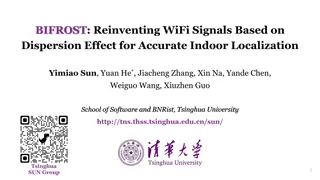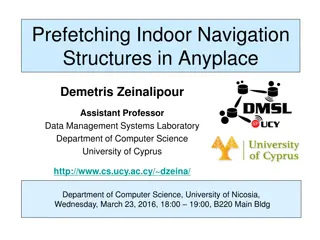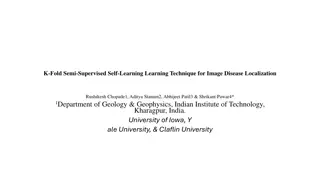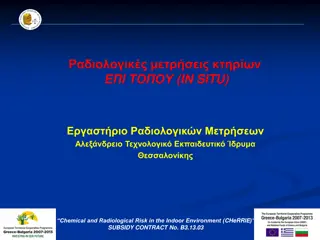Understanding Indoor Localization Algorithms
Indoor localization algorithms play a crucial role in determining the position of objects in indoor environments. Various methods such as GPS, TOA, TDOA, AOA, RSSI, and fingerprinting are employed for accurate localization. These algorithms measure factors like signal travel time, angle of arrival, and signal strength to determine the location of a target. Understanding these techniques is essential for efficient indoor positioning systems.
Download Presentation

Please find below an Image/Link to download the presentation.
The content on the website is provided AS IS for your information and personal use only. It may not be sold, licensed, or shared on other websites without obtaining consent from the author. Download presentation by click this link. If you encounter any issues during the download, it is possible that the publisher has removed the file from their server.
E N D
Presentation Transcript
A Brief Introduction of Indoor Localization Algorithms 5130309750 Chen Hongkun 2016/5/23
Structure of Indoor Localization Algorithms Introduction GPS TOA Range-free Bluetooth TDOA Indoor Localization Wi-Fi Range- based AOA ZigBee RSSI UWB Fingerprint
Time of Arrival Sometimes called Time of Flight, it is the travel time of a radio signal from a single transmitter to a remote single receiver TOA ???????? ? = ? ??? TDOA AOA r The Ap s position is already known, so the target is on a circle with radius r. RSSI Fingerprint Lab
Time of Arrival TOA TDOA AOA RSSI Fingerprint Lab
Time Difference of Arrival Other than absolute distance, it measures the difference TOA The receiver(cellphone) is on a hyperbolic curve TDOA Locate the target by finding the intersection AOA RSSI Fingerprint Lab
Time Difference of Arrival Question: TOA How to get the value of TDOA TDOA (Distance between R1 and T, R2 and T)? AOA Answer01: RSSI Using TOA Answer02: Fingerprint Using ? Lab
Angle of Arrival TOA It measures the angle TDOA Receiver is on a line AOA Finding the intersection RSSI Fingerprint How to measure the angle ? Lab
How to measure \theta ? TOA TDOA AOA d RSSI Fingerprint Lab d is what we have measured in TDOA
Time Difference of Arrival TOA Question: How to get the value of TDOA ? TDOA AOA Answer01: RSSI Using TOA Answer02: Fingerprint Using Lab
Angle of Arrival TOA We can measure phase difference ? TDOA ? =? 2???? AOA d RSSI ? = 2? ?/? Fingerprint ? = arcsin( ?/?) Lab
Received Signal Strength Indicator TOA DESCRIPTION: 1. A measurement of the power 2. RSSI declines with distance 3. Map between RSSI and distance TDOA AOA PROBLEM: Unstable, inaccuracy RSSI Fingerprint IMPROVEMENT: Will 2 Aps or more improve the accuracy of location ? Lab
STEPS: TOA 1. Record a vector of RSSIs (or other parameters) at a specific location 2. Compare the measuring vector with recorded vectors and find the optimum one TDOA AOA RSSI Fingerprint Lab
STEPS: TOA 1. Record a vector of RSSIs (or other parameters) at a specific location 2. Compare the measuring vector with recorded vectors and find the optimum one TDOA AOA RSSI Fingerprint Lab
Key Part. TOA Choose a good matching method. TDOA For example. AOA Euclidean distance RSSI Improvement: 1. Mean value model Fingerprint 2. Gaussian model Lab
What we have done in the lab: TOA TDOA Algorithm: Fingerprint-based AOA Size of room 4m* 5m Number of samples 15 RSSI Number of Ap 5 Fingerprint Accuracy 3m Lab
Problem 1. Multipath TOA TDOA Q: We suppose the two incoming signals are parallel here, but what if there are more or they are not parallel ? AOA RSSI Fingerprint Lab
Problem 2. Package Detection Delay TOA TDOA Q: Did the package detection delay be counted into TOA ? AOA ???????? ? = ? ??? RSSI 1?? 3 108?/? = 0.3? Fingerprint Lab
Problem 3. Synchronization TOA TDOA Q: How to make sure the synchronization has a precision of nanosecond level ? AOA inaccuracy RSSI 1?? 3 108?/? = 0.3? Fingerprint Lab
Problem 4. Phase difference TOA TDOA Q: Can we distinguish cases when ? = ? and ? = 3? ? When ? = 2? + ? AOA RSSI Fingerprint Lab
Problem 5. Intersection TOA TDOA Q: What if there are more than three Aps in which case there are more than one intersection ? AOA RSSI Fingerprint Lab
THNAK YOU Q & A























